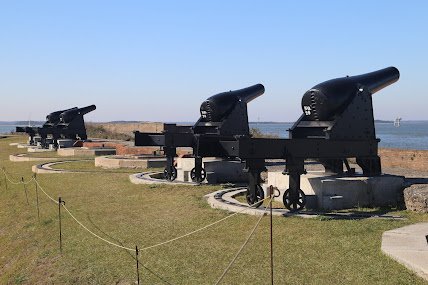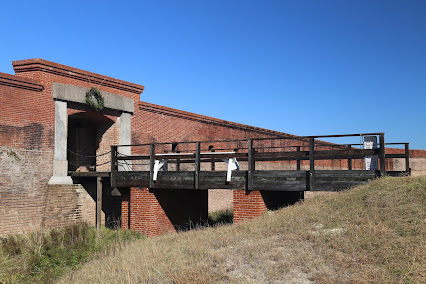Friday, December 18, 2020
Just a one minute walk from the Comfort Suites is the beach. Fortunately, I did bring a few extra layers. While I’m fine with the cold, I could do without the wind. But, I did find a spot along the wall of a beachside restaurant to get out of it, settle in and wait for the sunrise.
While waiting for the sun, here's some backstory on the island. While Spain was the first European country to claim ownership, if was actually French explorer Jean Ribault who established the first colony on the island, naming it Isla de Mar in 1562. Three years later, Spanish forces arrived and killed them all. In 1685, Spanish Franciscans arrived, built a mission and named the island Isla de Santa Maria. A small colony was established in an area now known as Old Town.
This sign is the only marker of the area. It's now a few small streets of typical coastal homes and BnB's. Oh yeah, there's also this house shaped like a boat for some reason.
As you might have guessed, I drove through here much later in the day. As for Old Town, British forces arrived and leveled the place in 1702 and renaming the island after Princess Amelia, King George II's daughter.
At the end of the Revolutionary War, Florida was given back to Spain. The town was renamed Fernandina, after King Ferdinand VII. Spanish control didn't last very long. In 1811, militia backed by the U.S. landed and took the island for the new country.
As for that sunrise, there was never a big light show, but there's still nothing quite like starting the day watching the sun rise.
Some days I go out for sunrise with my standard lens, as well as a bigger zoom lens. I wish I had this morning. The area directly around the rising sun suddenly got pretty dramatic.
The motel breakfast buffet was a little different than usual. Instead of warming trays and serving yourself, the eggs, bacon and grits were in the kitchen and passed to you beneath a plexiglass partition. In the public area, there were individual sized cereal boxes as well as fresh fruit. Each apple was in plastic wrap.
After breakfast, my first stop was just a couple of blocks west, Fort Clinch State Park. When you drive in towards the entrance station, there's a sign with the day use fees, as well as one claiming "exact change only." To avoid contact with the volunteer at the gate, you show him your cash, and drop in a locked box. Next to the box are park maps. There's no contact at all.
Here in Georgia, we don't have front tags on our cars. So, my CR-V has a NJ Devils tag in the front. Unless I'm looking for the car in a parking lot, I generally don't think anything of it. When I drove up, the volunteer asked, "are you from Jersey?" Yes, we really are everywhere. He retired and moved south from Caldwell. My high school football team used to play them every year.
From the entrance it's an easy drive through the aptly named Canopy Row to the fort.
As you approach the fort from the parking lot, it's hard to miss the flag flying behind the walls. This was the 1863-65 design. As more states were added, the star pattern simply no longer worked and it was dropped.
Construction of the fort began in 1847, for the purpose of protecting the shipping channels in south Georgia. The fort was two thirds complete at the outbreak of the Civil War. With no guns mounted, it was abandoned to the Confederates, who continued construction and armed the fort. With Union forces approaching, General Robert E. Lee would order the fort abandoned yet again. After the war, the fort would remain unfinished and empty.
Thirty years later, the Spanish-American war would bring the military back to Fort Clinch, mostly as a barracks and ammunition deport. As for those guns on the walls, they were never fired in anger. Their range was up to three and a half miles, further than any opposing naval vessel.
Not everything is accessible in the fort, but the you can access certain places via a circular stone stairway. There was just something about the textures and lighting..
As for the fort's namesake, Duncan Clinch, he joined the army as a lieutenant in 1808. Eight years later, as a lieutenant-colonel, he was ordered to attack the abandoned Fort Gadsen, southwest of Tallahassee. It was an old British fort built to protect their interests against Spain.
The fort was being occupied by Choctaw Indians and over three hundred free blacks and runaway slaves. Clinch's task was to clear the fort and return the slaves. Things didn't exactly go as planned. During the siege, the fort's powder magazine caught fire. The resulting explosion killed over three hundred.
The previous night, on the way back to the room, I wound my way through some back roads to the entrance gate for the Amelia Island Lighthouse. Considering I was trying to shoot a bright light in the dark, it didn't go very well.
There's a short trail off the main park road to an overlook . On the other side of the swamp was a clear view of the light. It was originally built in 1820 on Cumberland Island, just a few miles north. Eighteen years later, it was moved to it's new home. While only standing sixty-four feet, its light can be seen sixteen miles off shore.
Just for kicks, I drove back to the spot from the previous night.
On the drive in the day before, I passed the Mocama Brewing Company. It's a really nice place, with plenty of room and a great staff. However, they don't do food. But, they have delivery deals with three local places. I lingered for a while, enjoying a really nice porter.
With a the sun starting to head towards the horizon, I payed my check, tipped the staff nicely, and headed out I was looking for a place to settle in for sunset. Randomly driving north, I came across one private road after another, some with gates. I could see the horizon turning golden through the trees. The light show ended quickly. Eventually, I just turned around.
Considering that I hadn’t eaten since breakfast, all I wanted was some food. Sticking with my roadtrip rule about avoiding chain restaurants, I found myself at an uninspiring place called Sliders.




















No comments:
Post a Comment